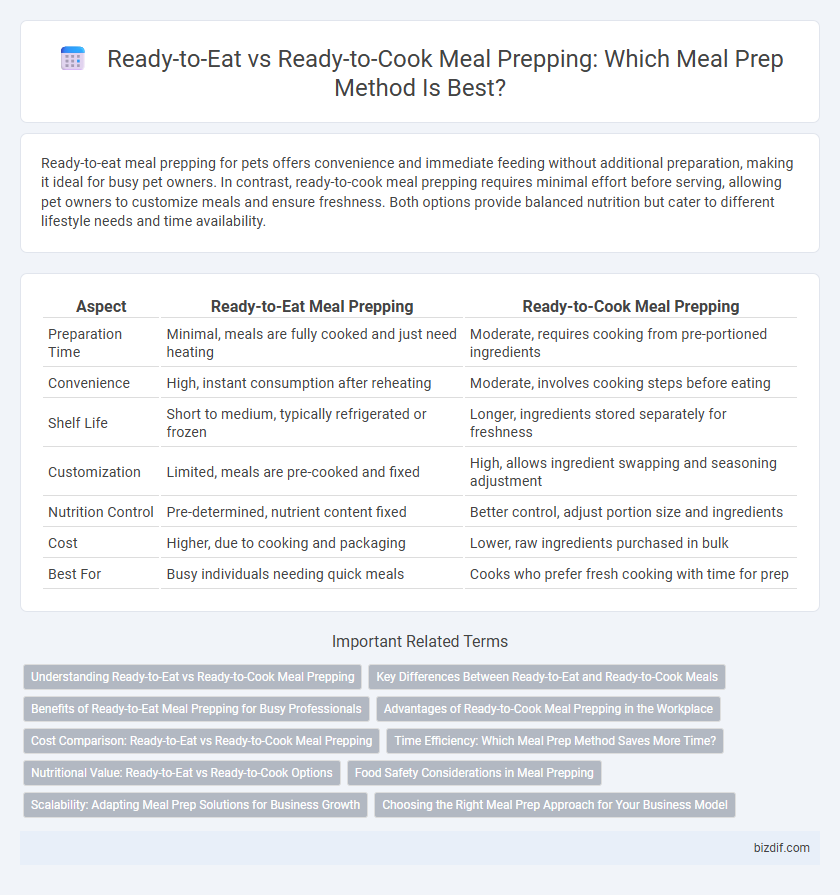Ready-to-eat meal prepping for pets offers convenience and immediate feeding without additional preparation, making it ideal for busy pet owners. In contrast, ready-to-cook meal prepping requires minimal effort before serving, allowing pet owners to customize meals and ensure freshness. Both options provide balanced nutrition but cater to different lifestyle needs and time availability.
Table of Comparison
| Aspect | Ready-to-Eat Meal Prepping | Ready-to-Cook Meal Prepping |
|---|---|---|
| Preparation Time | Minimal, meals are fully cooked and just need heating | Moderate, requires cooking from pre-portioned ingredients |
| Convenience | High, instant consumption after reheating | Moderate, involves cooking steps before eating |
| Shelf Life | Short to medium, typically refrigerated or frozen | Longer, ingredients stored separately for freshness |
| Customization | Limited, meals are pre-cooked and fixed | High, allows ingredient swapping and seasoning adjustment |
| Nutrition Control | Pre-determined, nutrient content fixed | Better control, adjust portion size and ingredients |
| Cost | Higher, due to cooking and packaging | Lower, raw ingredients purchased in bulk |
| Best For | Busy individuals needing quick meals | Cooks who prefer fresh cooking with time for prep |
Understanding Ready-to-Eat vs Ready-to-Cook Meal Prepping
Ready-to-eat meal prepping involves fully prepared dishes that require no further cooking, offering immediate convenience and time savings for busy individuals. Ready-to-cook meal prepping provides pre-portioned ingredients and recipes, allowing for fresh cooking while reducing prep time and minimizing food waste. Choosing between these options depends on lifestyle preferences, time availability, and desired meal freshness.
Key Differences Between Ready-to-Eat and Ready-to-Cook Meals
Ready-to-eat meal prepping offers fully cooked dishes that require no further preparation, providing immediate convenience and time savings, ideal for busy schedules. In contrast, ready-to-cook meal prepping involves pre-portioned ingredients and recipes, allowing customization and fresher flavors while demanding some cooking time. Nutritional preservation tends to be higher in ready-to-cook meals due to less processing, whereas ready-to-eat meals emphasize ease and speed.
Benefits of Ready-to-Eat Meal Prepping for Busy Professionals
Ready-to-eat meal prepping offers busy professionals significant time savings by eliminating cooking and preparation during hectic workdays. These meals ensure consistent portion control and nutritional balance, supporting health goals without the stress of meal assembly. Convenient packaging and long shelf life reduce food waste and enhance meal variety, making it an efficient choice for maintaining a healthy lifestyle amidst a demanding schedule.
Advantages of Ready-to-Cook Meal Prepping in the Workplace
Ready-to-cook meal prepping in the workplace offers greater flexibility by allowing employees to customize cooking times and flavors, enhancing meal freshness and satisfaction. It helps maintain nutritional value by enabling control over cooking methods, benefiting health-conscious individuals. This approach also reduces food waste as portions can be adjusted before cooking, promoting cost-efficiency in office meal management.
Cost Comparison: Ready-to-Eat vs Ready-to-Cook Meal Prepping
Ready-to-cook meal prepping typically reduces overall food expenses by allowing purchase of raw ingredients in bulk, which is often more cost-effective than pre-packaged ready-to-eat meals. Ready-to-eat options incur higher costs due to added convenience, packaging, and processing fees. For budget-conscious individuals, ready-to-cook meal prepping offers greater savings without sacrificing meal quality or variety.
Time Efficiency: Which Meal Prep Method Saves More Time?
Ready-to-eat meal prepping offers significant time savings by eliminating the need for cooking during meal times, providing immediate access to fully prepared meals. Ready-to-cook meal prepping requires additional time for cooking, but allows for fresher meals and customization just before eating. For maximum time efficiency, ready-to-eat meal prep is superior since it minimizes daily food preparation and cleanup efforts.
Nutritional Value: Ready-to-Eat vs Ready-to-Cook Options
Ready-to-cook meal prepping often preserves higher nutritional value as ingredients remain fresh until cooking, maintaining vitamins and minerals that may degrade during processing. Ready-to-eat meals can lose some nutrients due to cooking, freezing, or preservatives required for longer shelf life. Choosing ready-to-cook options provides greater control over seasoning and cooking methods, supporting a healthier meal tailored to dietary preferences.
Food Safety Considerations in Meal Prepping
Ready-to-eat meal prepping requires strict adherence to refrigeration and hygiene standards to prevent bacterial growth and foodborne illnesses during storage and consumption. Ready-to-cook meal prepping demands careful handling of raw ingredients, proper packaging, and timely freezing to maintain freshness and inhibit contamination. Both methods benefit from using airtight containers and labeling with preparation and expiration dates to ensure food safety throughout the meal prep cycle.
Scalability: Adapting Meal Prep Solutions for Business Growth
Ready-to-eat meal prepping offers immediate consumption convenience but may face challenges in large-scale storage and distribution due to perishability. Ready-to-cook meal prepping enhances scalability by allowing businesses to streamline packaging and extend shelf life, facilitating bulk production and flexible delivery schedules. Optimizing supply chain logistics and inventory management is essential for scaling either meal prep model effectively in business operations.
Choosing the Right Meal Prep Approach for Your Business Model
Choosing the right meal prep approach for your business model involves evaluating customer preferences and operational capabilities. Ready-to-eat meal prepping caters to convenience-seeking customers and demands efficient packaging and storage solutions, while ready-to-cook meal prepping appeals to those who prefer cooking at home and requires clear ingredient labeling and cooking instructions. Aligning your meal prep style with your brand identity and distribution channels ensures operational efficiency and customer satisfaction.
Ready-to-eat meal prepping vs ready-to-cook meal prepping Infographic

 bizdif.com
bizdif.com